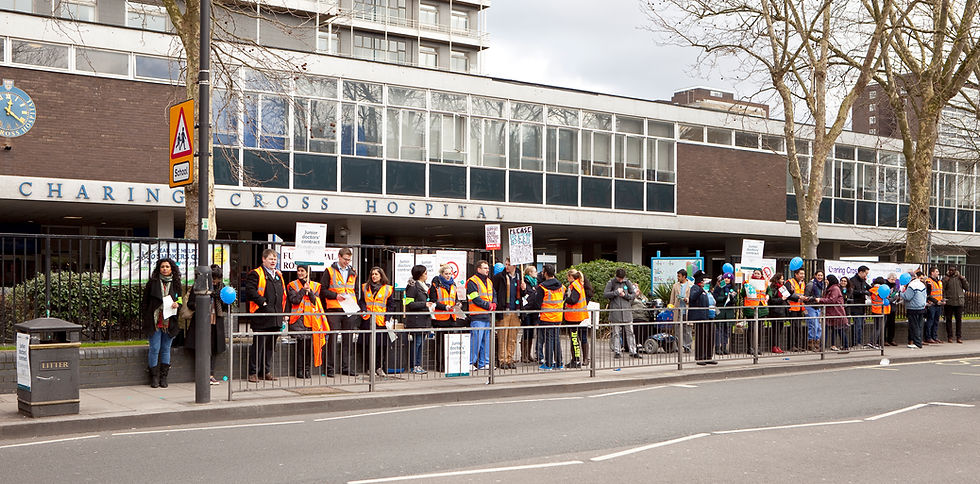Why Resident Doctors Are Demanding 29%—And Why It Matters
- WhatTheBleep
- Jul 26
- 3 min read

The recent call by the BMA for a real-terms pay restoration for resident doctors has reignited debate over how the NHS values its training-grade workforce. The demand—a 29% increase to reverse the erosion of pay since 2008—is not a sudden or opportunistic ask. It's the culmination of over a decade of quiet financial attrition, now reaching a breaking point in a workforce exhausted by COVID-19, staffing shortages, and relentless service pressures.
At the heart of this dispute is a fundamental question: what does the NHS believe its junior doctors are worth?
Pay Restoration vs Pay Rise
Some commentators have mischaracterised the 29% figure as an unrealistic pay hike. In truth, it reflects the cumulative decline in real-terms pay since 2008, as calculated by independent economic analysis. Between 2008 and 2022, junior doctors’ salaries declined by approximately 26% when adjusted for inflation, one of the steepest losses in the public sector.
What the BMA is now seeking is not a bonus or windfall, but restoration. That is, a return to the 2008 pay baseline, before austerity-era freezes and caps took hold. The context is key: no other high-skill profession in the UK has seen such a sustained reduction in its starting salaries, especially in the face of soaring inflation, student debt, and higher tax burdens.
While the government has offered a cumulative 22% uplift across 2023–25, and an additional 5.4% in 2025–26, this still falls short of reversing over a decade of suppressed earnings.
Working Through a Crisis, Then Left Behind
Resident doctors, commonly referred to as junior doctors, were at the forefront throughout the COVID-19 pandemic. They shouldered the lion’s share of surge rotas, redeployment, and out-of-hours escalation, often without adequate PPE, rest, or support. That effort was never fully recognised—no COVID bonus, no formal recovery period, and no protection from the financial fallout of inflation and pay erosion.
It is not only a question of fairness, but of signalling: when professionals are pushed to the brink in national emergencies, is their contribution rewarded or quietly forgotten?
The Risk of Further Strikes
The BMA’s latest ballot returned a strong mandate for industrial action, with 90% voting in favour on a 55% turnout. A five-day strike is now planned for 25–30 July—one of the longest walkouts in NHS history. NHS leaders have warned of widespread disruption, and there is no doubt that patients will be affected. But it is equally important to acknowledge that continued underinvestment in the medical workforce is already harming patients every day, through longer waits, rushed reviews, and reduced continuity of care.
Junior doctors do not strike lightly. Each day on a picket line is a day they are not delivering care, gaining experience, or progressing in training. But for many, it is the only remaining tool to force serious negotiation after years of being dismissed.
Systemic Neglect and Workforce Consequences
The root of this crisis is deeper than any one contract dispute. The NHS has relied for too long on the goodwill and flexibility of its training workforce to prop up a system under strain. High vacancy rates, rota gaps, excessive workloads, and moral injury have led to burnout, emigration, and early exits from the profession. Nearly three-quarters of junior doctors now opt out of the NHS pension scheme—not out of ignorance, but out of necessity.
If resident doctors continue to feel undervalued and underpaid, the pipeline of future consultants, GPs, and medical leaders will dry up. The NHS will find itself increasingly reliant on locums, overseas recruitment, and expensive agency cover to sustain basic services.
Political Will and the Possibility of a Solution
The government has made clear it will not meet the BMA’s 29% figure in full this year. But the union has already signalled openness to a phased approach over multiple years. That opens the door to negotiation if both sides engage in good faith.
One possible solution would involve a multi-year pay restoration plan alongside broader reforms: improved rostering practices, protected training time, and fairer pension contributions. There is room for creativity, but only if policymakers accept the basic principle that resident doctors are owed more than warm words and symbolic gestures.
Conclusion
This dispute is not about greed. It is about professional respect, financial justice, and the future of a workforce that holds the NHS together.
If the government hopes to retain talent, rebuild morale, and steer the health service out of crisis, it must stop seeing junior doctors as a cost centre and start recognising them as the investment they are.




The variety of payment methods at Digitis7 Casino is excellent, accommodating both traditional banking and modern e-wallets. I was particularly impressed with the withdrawal speed. My winnings were processed https://digits7casino.bet and sent to my account much faster than I expected, with the entire process completed in just over 24 hours. A hassle-free and efficient banking experience.